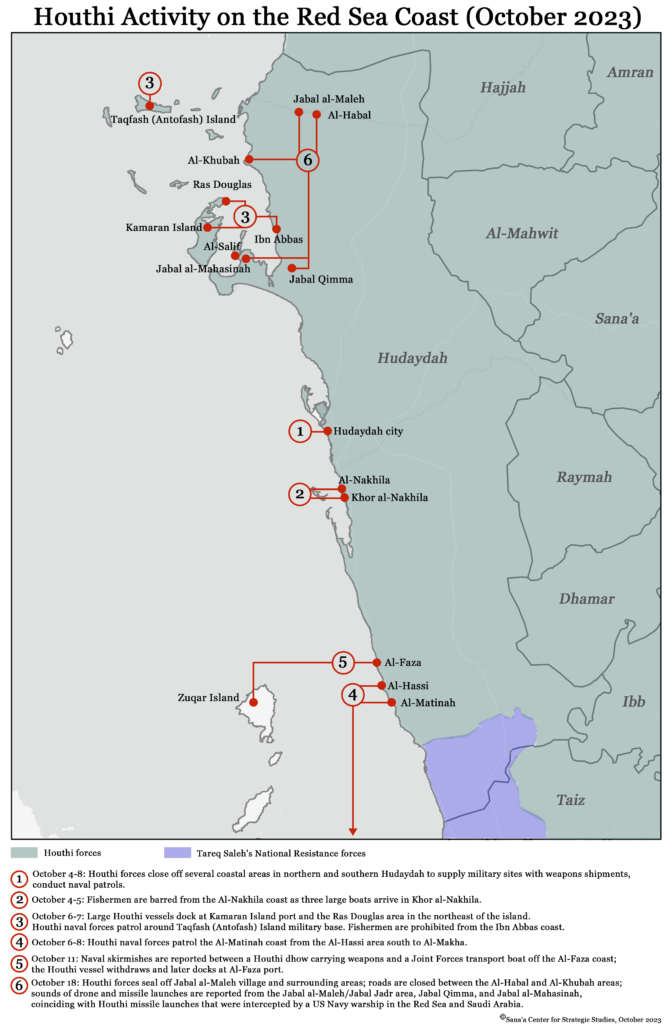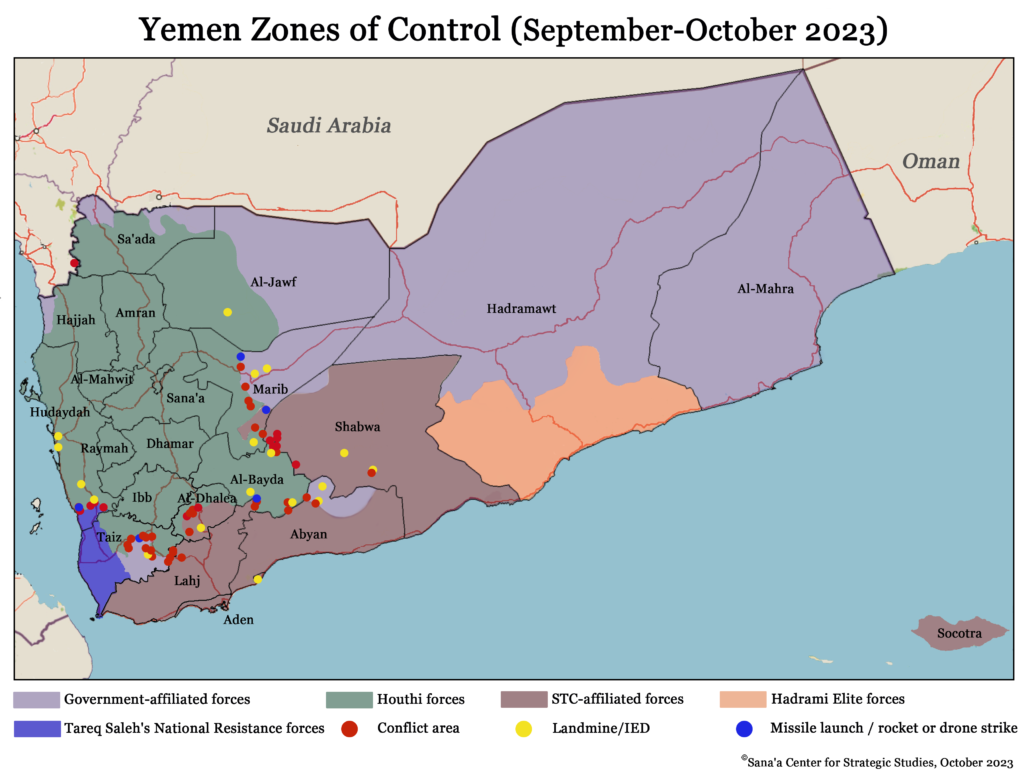The outbreak of conflict between Israel and Hamas in Gaza on October 7 galvanized Houthi forces, who have used their strategic position on the Red Sea to threaten Israeli and US forces in the region – or at least give their supporters the impression that they are doing so. This culminated on October 31, when Houthi military spokesman Yahya Sarea gave a televised speech claiming three missile and drone strikes in the Red Sea, threatening to continue attacks as long as the Israeli campaign in Gaza continued. A flurry of Houthi military activity took place in the weeks preceding the missile launches, suggesting that Houthi forces have militarized large swaths of the Hudaydah coastline and Red Sea islands, giving them a strategic position from which to threaten not only Israeli cities, but also US ships and commercial activity in the Red Sea.
Houthi operations in the Red Sea have recently centered around the group’s bases on Kamaran and Taqfash Islands, two of more than 15 islands that the group controls off the western coast of Hudaydah. The eastern areas of Kamaran Island are particularly strategic, as they are interspersed with mangrove forests which provide cover across the many inlets and ports in the area. Taqfash – which is known locally as Antofash Island and has likely been home to a Houthi base since August – is also tactically valuable, as it is one of the largest Red Sea islands and the closest to the international shipping lane. Early September witnessed a number of Houthi naval boats launching from these areas, with patrols reported near Taqfash Island, as well as Jabal al-Tair Island and the Zubair Archipelago to the west of Kamaran Island on September 11 and throughout October. In October, locals reported Houthi training exercises involving amphibious naval teams and naval commando units, as well as mock drone raids over Kamaran’s mangrove forests.
Events escalated in early October when Houthi forces closed off several coastal areas in northern and southern Hudaydah between October 4-8 to allow the supply of weapons shipments and materiel to military sites. During this time period, three large boats arrived at Khor al-Nakhila to the south of Hudaydah city and several large boats entered the Kamaran Island port and visited a northeastern part of the island called Ras Douglas. Fishermen were concurrently prohibited from working in these areas.
Early October also saw activity off the Al-Matinah coast of Al-Tuhayta district in southern Hudaydah as Houthi forces patrolled their territorial waters. On October 11, naval skirmishes occurred off the Al-Faza coast in the west of Al-Tuhayta district after a Houthi-flagged dhow, reportedly carrying a shipment of weapons, briefly exchanged fire with a Joint Forces-flagged transport boat, causing the Houthi vessel to withdraw.
On October 18, local residents in Hudaydah’s northwestern Al-Lahiya district reported hearing missile and drone launches from Houthi-controlled areas near the village of Jabal al-Maleh, Jabal Qimma, Al-Salif city, and Ras Issa. Houthi construction has been ongoing in several of these areas and they have been cordoned off since 2020. The following day, on October 19, the Pentagon announced that the USS Carney had intercepted four Houthi missiles and drones in the Red Sea which, based on their trajectory, could have been targeting Israel. Prime Minister of the Houthi-led government Abdelaziz bin Habtour took responsibility for the incident and warned that attacks would continue.
On October 27, two drones were downed over the Egyptian coastal towns of Taba and Nuweiba. The Israeli military linked these drones to the Houthis, reporting that they intercepted the drones before they could reach their presumed target, the nearby southern Israeli port of Eilat. On October 31, another projectile was intercepted outside Eilat. Houthi leader Hezam al-Asad’s hints that the group was involved in both attacks appeared to be confirmed on October 31, when Houthi spokesman Yahya Sarea gave a speech saying that Houthi forces had launched three assaults on Israel. The following day, Sarea announced a fourth attack on X (formerly Twitter), which remains unconfirmed.
While the ability of the Houthis t0 actually strike targets in Israel remains in question, the attacks do have several major implications and highlight the Houthis’ ability to threaten strategic interests in the region. Houthi forces could turn their attention to Red Sea targets. Washington announced the arrival of an Ohio-class submarine to the Red Sea on November 4. In response to promised Houthi attacks on “Zionist” assets in the region, the Israeli military announced on November 1 that it had deployed missile ships in the Red Sea. Retaliation could include a combination of hard- and soft-power maneuvers, including the assassination of senior Houthi members in the following months or the reclassification of the Houthi group as a terrorist organization – which Washington policymakers are already keen to move forward on. Regardless, while continued Houthi involvement in the Gaza crisis may be popular with the group’s domestic base, it remains unclear at what cost.
September Revolution Celebrations Spark Security Crackdowns
The commemoration of both the Houthi takeover of Sana’a on September 21 and the anniversary of the 1962 revolution against the Zaidi imamate in North Yemen on September 26 caused a wave of security crackdowns as Houthi forces attempted to quell dissent over their own celebrations and prevent the observance of the Republican Revolution, which has become a symbol of resistance against Houthi rule.
A massive Houthi military parade was staged to celebrate the ninth anniversary of the Houthi takeover of Sana’a, with thousands of soldiers taking to the streets and a number of new weapons being showcased. Among these were replicas of Iranian missiles and drones, and an F-5 fighter jet, which flew overhead for the first time during the war.
In the days preceding the September 26 Revolution celebrations, Houthi forces arrested more than a thousand civilians in Sana’a as citizens took to the streets waving banners and republican flags. Across Houthi-held territories, Houthi forces attempted to break up the celebrations, often beating participants or destroying their property. Following the holiday, Houthi authorities continued to hold hundreds of people in detention, forcing some to sign pledges to cease all participation in public disorder prior to release. On September 30, hundreds of residents of Al-Dhalea’s Qaataba District protested these arrests, and in Hudaydah dozens of armed Houthi soldiers were deployed throughout Hudaydah city, with armored vehicles blocking major streets and snipers positioned on rooftops across the city.
In government-held territories, pro-government officials used the holiday as an opportunity to stage military parades of their own. On September 26, Yemeni army forces displayed a number of weapons, including missiles and drones at a large parade in Marib city.
Houthis Clash with Coalition Forces
September and October saw a rare outbreak of clashes between the Houthis and forces from the Saudi-led coalition, representing the first acknowledged fighting between the two sides since a UN-brokered truce was signed in April 2022. On September 25, Bahrain announced that two Bahraini soldiers had been killed and several others wounded in an alleged Houthi drone strike along the Saudi-Yemen border. A third Bahraini soldier died from his injuries two days later, a fourth was announced dead on September 29, and a fifth died about a month later.
On October 24, at least four Saudi soldiers were killed in clashes on the border between Saudi Arabia’s Jazan district and Yemen’s Hajjah governorate after Houthi forces attempted to destroy surveillance cameras that were recently installed in the border area near Jabal al-Doud, according to government, Houthi, and Saudi military sources. Houthi forces briefly took control of Jabal al-Doud for several hours, with some reports indicating that they remained in the area until the morning of November 1 in order to disable the surveillance equipment, and later withdrew.
Fighting in Al-Dhalea
Clashes in Al-Dhalea resulted in heavy casualties on all sides as Houthi forces engaged STC- and government-affiliated forces on frontlines across the governorate. In the last two months, at least 191 Houthi soldiers were wounded and another 77 were killed. Anti-Houthi forces sustained significant damages as well, with at least 164 soldiers wounded and another 79 killed in combat. Fighting seems to have favored Houthi forces in the latter half of the reporting period – of the anti-Houthi forces wounded, over 100 were injured in October alone. Despite the high casualties, neither side was able to make significant territorial advances.
October also saw the attempted assassination of several STC military leaders based in Al-Dhalea. On October 1, unidentified gunmen killed STC leader Abdo Mohammed Saleh al-Bakri in front of his house in the village of Shaab Qasr in the Bani Saeed area in the center of Jahaf district, according to tribal sources. The commander of the 4th Sector of the STC-affiliated Security Belt Forces in Al-Dhalea, Zaghloul Ali Mohammed, and an STC-affiliated Security Belt forces commander, Aboud al-Jaridhi, survived assassination attempts by unidentified gunmen on October 16 and 18, respectively.
Other Developments in Brief:
September 7: Clashes broke out between two rival ethnic groups of Ethiopian migrants in the border region between Aden’s Dar Saad district and Lahj’s Tuban district, according to a local activist, with clashes and looting continuing in Sheikh Othman district the following day. STC-affiliated Security Belt forces began rounding up hundreds of Ethiopian and Somali migrants on September 10 and transporting them to the Basateen area of Dar Saad district.
September 13: The families and fellow tribesmen of dozens of soldiers from the Republican Palace Protection Battalion of the Hadrami Elite forces demanded a formal investigation into inhumane treatment by officers at the Al-Rabwa camp near Mukalla. According to a statement submitted to Hadramawt Governor Mabkhout bin Madi’s office, family members claim that Emirati officers at the camp beat their sons with sticks, batons, and rifle butts before leaving them tied up for several hours, and then forcibly shaved their heads, eyebrows, and mustaches.
October 3: Security forces in Mukalla launched the “Scales of Justice” security campaign with support from 2nd Military Region forces, targeting individuals charged with the crimes of rioting and disturbing the peace. Hadramawt Governor Mabkhout bin Madi characterized the campaign as a success, while local journalists and activists decried it as a “violation” against dozens of citizens who had their homes raided.
October 4: A roadside bomb killed the commander of the STC-affiliated Security Belt forces for the Shuqra sector, Salem Ali Sal’an, and injured five soldiers during a military patrol in the village of Urma in Mudiya district in northeast Abyan, where counterterrorism forces have been battling Al-Qaeda militants for over a year, according to a Security Belt source.
October 14: Houthi forces staged a military parade in Al-Bayda’s Al-Sawadiyah camp. President of the Supreme Political Council Mahdi al-Mashat attended the event, along with Minister of Defense Mohammed Nasser al-Atifi and several other high-ranking military leaders. The day before, during preparations for the parade, armed clashes broke out between Al-Rayam tribesmen and Houthi Preventative Security Forces. The local commander of the Houthi forces, Hadi Ghanem al-Qasma (Abu Tareq), was killed in the ensuing fighting, along with more than 15 fighters from both sides, according to local sources.

 اقرأ المحتوى باللغة العربية
اقرأ المحتوى باللغة العربية
